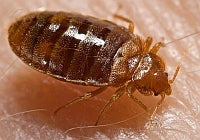
With the drastic increase in bedbug infestation over the last several years, scientists and researchers have searched for safe, cost-effective methods of eliminating these pests.
Because bedbugs are attracted by the elevated carbon dioxide levels in human respiration, CO2 can be used to determine if a bedbug infestation exists. And because high levels of CO2 kills bed bugs, pest control companies are using CO2 instead of toxic insecticides to fumigate hotel rooms and even entire buildings.
Bedbugs can live for months between feedings. When a bedbug senses a rise in CO2 levels, it will follow the CO2 to its source. In most cases, this will be a human host. Once the bedbug has found the host, it feeds, then returns to its hiding place again.
Pest control specialists can test for the existence of bedbugs by using a cylinder of CO2 gas or dry ice in a bucket (dry ice is frozen CO2) to “fool” the bedbugs into coming out of hiding. Even if a single bedbug is attracted to the CO2 source, it signifies a much larger bedbug infestation.
If bedbugs are discovered, the fastest growing solution is to hire an exterminator that uses Cryonite, a compressed CO2 product that is sprayed on surfaces and in cracks where bed bugs are likely to hide. Cryonite works by instantly freezing the bedbugs (or any other pest). After a few seconds, the Cryonite warms and converts into normal CO2 gas.
Since CO2 is poisonous to humans in high volumes, several companies use our hand-held 30% Sample Draw CO2 Meters to test for dangerous CO2 levels. The real-time display instantly alerts workers to elevated CO2 levels during CO2 fumigation.

